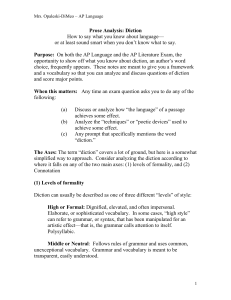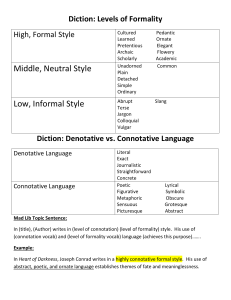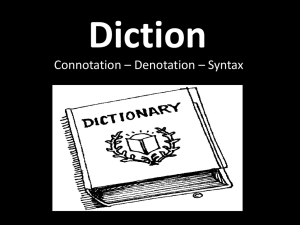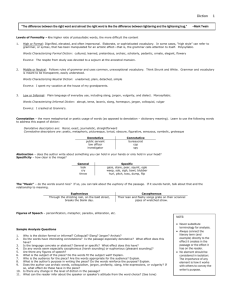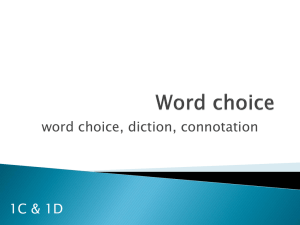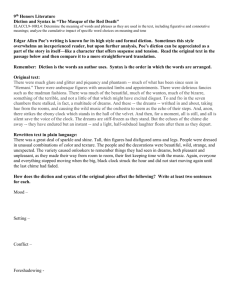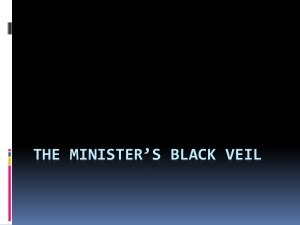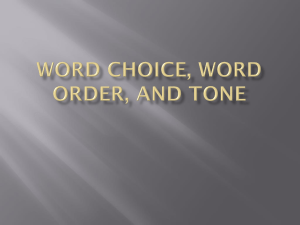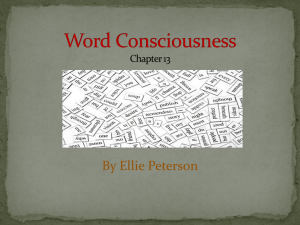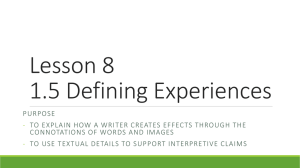Prose Analysis: Diction
advertisement
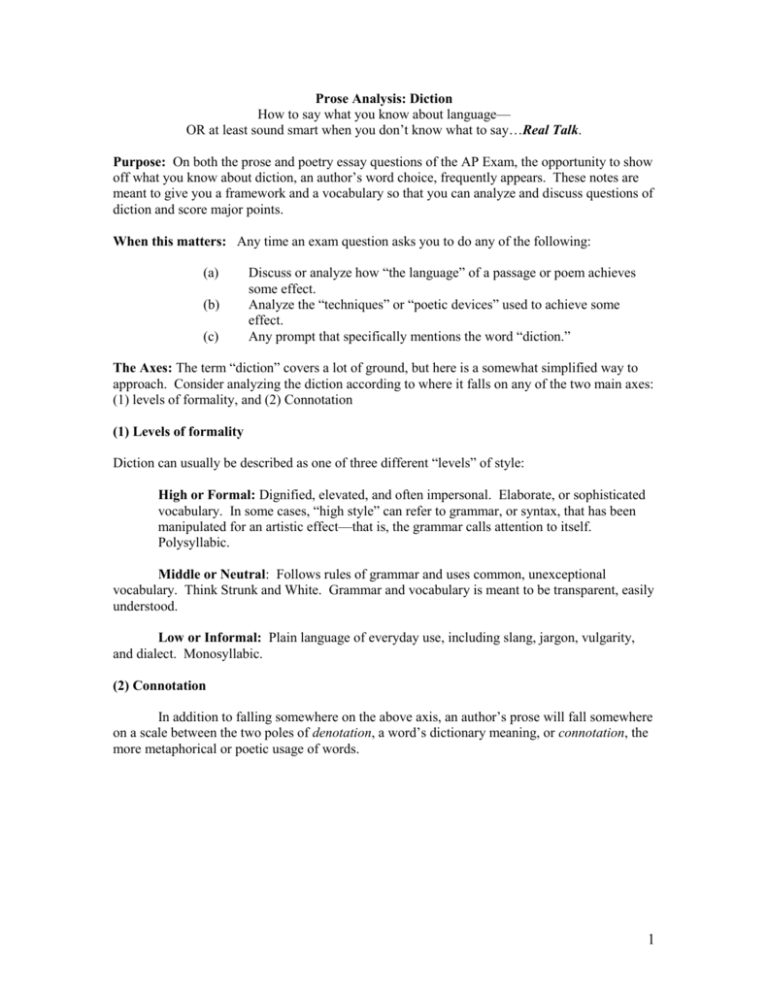
Prose Analysis: Diction How to say what you know about language— OR at least sound smart when you don’t know what to say…Real Talk. Purpose: On both the prose and poetry essay questions of the AP Exam, the opportunity to show off what you know about diction, an author’s word choice, frequently appears. These notes are meant to give you a framework and a vocabulary so that you can analyze and discuss questions of diction and score major points. When this matters: Any time an exam question asks you to do any of the following: (a) (b) (c) Discuss or analyze how “the language” of a passage or poem achieves some effect. Analyze the “techniques” or “poetic devices” used to achieve some effect. Any prompt that specifically mentions the word “diction.” The Axes: The term “diction” covers a lot of ground, but here is a somewhat simplified way to approach. Consider analyzing the diction according to where it falls on any of the two main axes: (1) levels of formality, and (2) Connotation (1) Levels of formality Diction can usually be described as one of three different “levels” of style: High or Formal: Dignified, elevated, and often impersonal. Elaborate, or sophisticated vocabulary. In some cases, “high style” can refer to grammar, or syntax, that has been manipulated for an artistic effect—that is, the grammar calls attention to itself. Polysyllabic. Middle or Neutral: Follows rules of grammar and uses common, unexceptional vocabulary. Think Strunk and White. Grammar and vocabulary is meant to be transparent, easily understood. Low or Informal: Plain language of everyday use, including slang, jargon, vulgarity, and dialect. Monosyllabic. (2) Connotation In addition to falling somewhere on the above axis, an author’s prose will fall somewhere on a scale between the two poles of denotation, a word’s dictionary meaning, or connotation, the more metaphorical or poetic usage of words. 1 How to talk about levels of formality One thing that is really impressive is having a large bank of words that you know that you can use to characterize the different kinds of diction. You can use this stuff when fashioning terribly impressive thesis statements—even when you don’t have any idea what you’re talking about! That is what the following notes are for. Many of these words can be used to describe syntax as well as diction. High, Formal Style Cultured Learned Pretentious Archaic Scholarly Pedantic Ornate Elegant Flowery Middle, Neutral Style Unadorned Plain Detached Simple Low, Informal Style Abrupt Terse Laconic Homespun Colloquial Vulgar Slang Jargon 2 How to talk about Connotation Language can also fall somewhere on the following scale. Few works of literature are purely denotative, of course, but they are connotative to varying degrees. Speak of a passage as being “highly connotative” or Learn to use these words to discuss connotation. Denotative language Literal Exact Journalistic Straightforward Connotative language Poetic Lyrical Figurative Symbolic Metaphoric Obscure Sensuous Grotesque Picturesque Additional aspects of word choice. Abstraction In addition, an author’s language will fall somewhere on a scale between the poles of abstract and concrete language. That is, do they write about stuff you can hold in your hands, or stuff you can only hold in your heads? The Music Do the words sound nice? If so, you can talk about the euphony, words that sound pleasant to the ear, of the passage and its effect… If it sounds harsh or has discordant sounds, you can talk about the cacophony of the words and the relationship to meaning. Figures of Speech You know all these, right? Personification, Metaphor, Alliteration, etc. 3 How do I use this great new vocabulary to craft smart topic sentences? First: Don’t respond to a prompt by saying that the author “uses diction.” You are saying nothing if you say that. Everyone uses “word choice”—your job is to characterize that word choice. What I suggest: A convoluted, excruciating, five-step process. Step One: Levels of Formality 1. “Do” a close reading on the passage, first identifying any unusual or characteristic words. If there are none, you are probably reading something with a “middle style.” 2. If words stand out, you should be able to decide whether the passage leans to the high or low styles. If so, pick a snazzy vocab word to describe what kind of high or low diction it is. Step Two: Connotation 1. Examine how the words appear to be used—do they seem to be used like poetry, with lots of external, thematic meanings attached, or are they more literal, like a straightforward action story? 2. Once you decide which way it leans, connotative or denotative, pick some vocab words that characterize the diction more specifically. Step Three: Miscellaneous Ask yourself about abstraction/ concreteness, what figures of speech you see, and the sounds of the language. Step Four: Purpose 1. Sit back for a moment and ask yourself what purpose of the word choice appears to be fulfilling. 2. For example, you can always say that it sets a tone—just make sure you have some words ready to describe that tone. 3. Also consider whether the word choice is having an effect on character, symbol/theme, setting, etc. Step Five: The Analytical Statement. aka… “The Topic Sentence” or “The Thesis Statement” Let’s play Madlibs!!! “In [name of work], [Author] writes in a [connotation] [level of formality] style. Her use of [connotation vocab] and [level of formality vocab] language [achieves this purpose].” For example: “In Heart of Darkness, Joseph Conrad writes in a highly connotative high style. His use of abstract, poetic, and ornate language establishes existential themes of fate and meaninglessness.” 4
